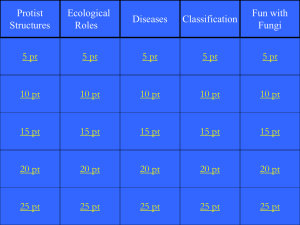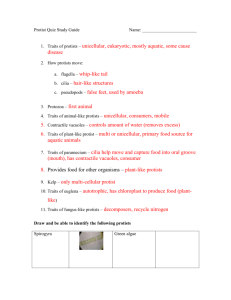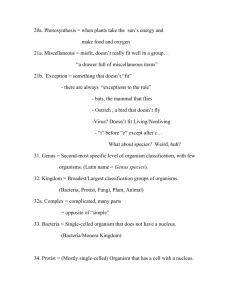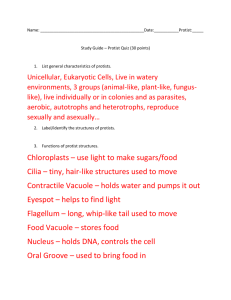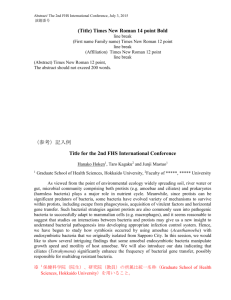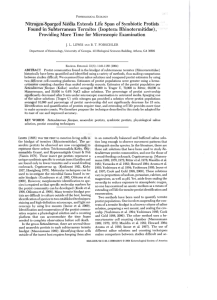Genetics Review
advertisement
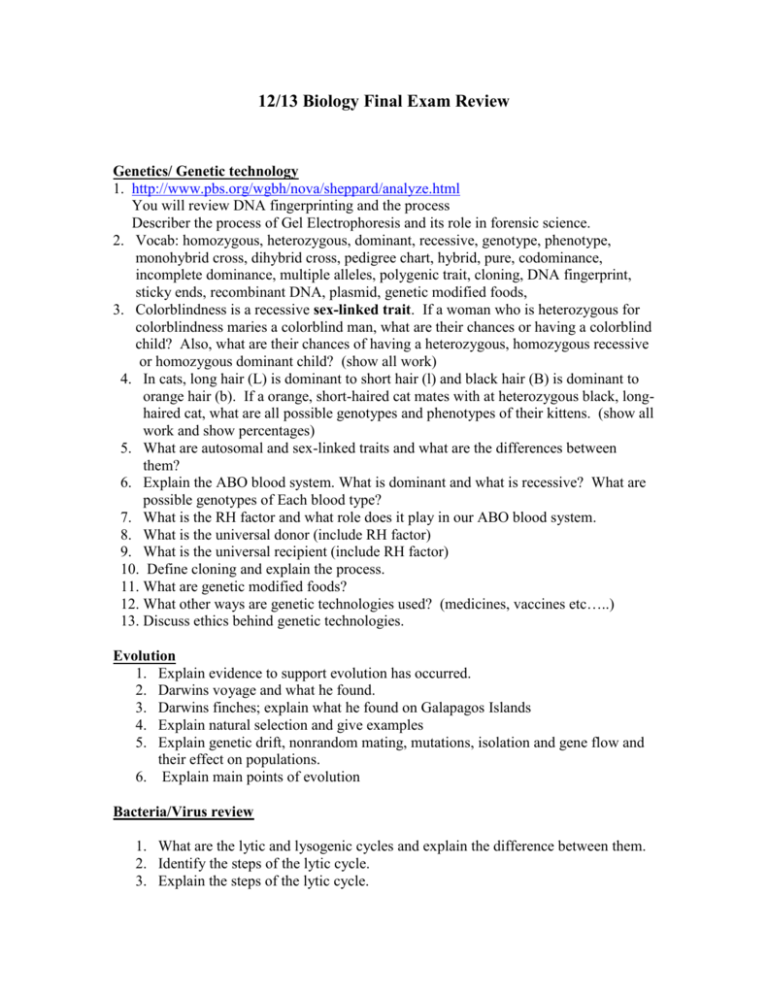
12/13 Biology Final Exam Review Genetics/ Genetic technology 1. http://www.pbs.org/wgbh/nova/sheppard/analyze.html You will review DNA fingerprinting and the process Describer the process of Gel Electrophoresis and its role in forensic science. 2. Vocab: homozygous, heterozygous, dominant, recessive, genotype, phenotype, monohybrid cross, dihybrid cross, pedigree chart, hybrid, pure, codominance, incomplete dominance, multiple alleles, polygenic trait, cloning, DNA fingerprint, sticky ends, recombinant DNA, plasmid, genetic modified foods, 3. Colorblindness is a recessive sex-linked trait. If a woman who is heterozygous for colorblindness maries a colorblind man, what are their chances or having a colorblind child? Also, what are their chances of having a heterozygous, homozygous recessive or homozygous dominant child? (show all work) 4. In cats, long hair (L) is dominant to short hair (l) and black hair (B) is dominant to orange hair (b). If a orange, short-haired cat mates with at heterozygous black, longhaired cat, what are all possible genotypes and phenotypes of their kittens. (show all work and show percentages) 5. What are autosomal and sex-linked traits and what are the differences between them? 6. Explain the ABO blood system. What is dominant and what is recessive? What are possible genotypes of Each blood type? 7. What is the RH factor and what role does it play in our ABO blood system. 8. What is the universal donor (include RH factor) 9. What is the universal recipient (include RH factor) 10. Define cloning and explain the process. 11. What are genetic modified foods? 12. What other ways are genetic technologies used? (medicines, vaccines etc…..) 13. Discuss ethics behind genetic technologies. Evolution 1. Explain evidence to support evolution has occurred. 2. Darwins voyage and what he found. 3. Darwins finches; explain what he found on Galapagos Islands 4. Explain natural selection and give examples 5. Explain genetic drift, nonrandom mating, mutations, isolation and gene flow and their effect on populations. 6. Explain main points of evolution Bacteria/Virus review 1. What are the lytic and lysogenic cycles and explain the difference between them. 2. Identify the steps of the lytic cycle. 3. Explain the steps of the lytic cycle. 4. How are viruses spread in humans (list several ways)? 5. Are viruses living or nonliving? Support your answer. 6. Are bacteria living or nonliving? Support you answer. 7. What are the basic shapes of viruses? Give examples for each. 8. What basic structures do all viruses have (should be 2 structures)? 9. Explain RNA, DNA, prions, viroids, and retroviruses and give examples of each. 10. What are the 3 basic shapes of bacteria? 11. Explain Gram-positive and Gram-negative. Be sure to give the color it turns and its significance. 12. What enables bacteria to be gram-negative? 13. Explain sexual and asexual reproduction in bacteria: Be sure to tell me what the process is called and what happens. 14. What are the 2 kingdoms in bacteria? 15. Explain and Give examples of the 3 types of Archeabacteria. 16. Who was the first person to see bacteria under a microscope? 17. Are bacteria prokaryotic or eukaryotic? Support your answer. 18. What are chemoautotophs and nitrogen-fixing bacteria? Give examples 19. Give the function of the following structures of a bacterium: DNA (nucleoid), cytoplasm, cytoplasmic (cell) membrane, pili, flagella, capsule, cell wall, ribosomes. 20. Define anaerobic, aerobic, facultative anaerobic, saprophyte, conjugation, binary fission. 21. Draw the following: Diplococcus, Streptobacillus, Staphylobacillus, Tetraspirillus, Diplospirillus, Streptococcus Symmetry, Position, Sponges, Hydra 1. List the position terms and their location on the body. 2. What organism means “pore-bearer” and why. 3. Explain what sponging and spicules are and difference between them. 4. What does “endo” and “ecto” mean. 5. What structure is bell-shaped and motile. 6. What structure is flower-shaped and sessile. 7. What does motile and sessile mean. 8. What are the parts of a sponge and what are their functions? (ie: osculum, pores….) 9. Explain the 3 types of symmetry and give examples of each. 10. What phylum are hydras in. 11. How do hydras move, reproduce, eat? Planaria/Earthworms/Roundworms/Mollusks 1. Be able to explain the different characteristics of the 3 phylums of mollusks. 2. Be able to explain the structure and their functions in planaria. 3. How do planaria eat and excrete? 4. Explain how earthworms move (explain role of longitudinal and circular muscles. 5. Explain circulatory, reproductive, digestive systems in earthworms. Protists 1. List animal like protists and give their distinguishing characteristic for each. 2. What protist provides most of the earth’s oxygen? 3. What nucleus is involved in paramecium reproduction? 4. Name and list examples of the 3 groups protists are divided into. 5. Matching _____ Conjugation _____ Pellicle _____ flagella _____ binary fission _____ cilia _____ pseudopodia _____ Food vacuole _____ eyespot _____ contractile vacuole _____ micronucleus _____ macronucleus a. b. c. d. gets rid of excess water aids in paramecium to move Sexual reproduction Give shape and protection of paramecium e. helps amoebas to move f. helps Euglena to move g. detects light h. digests food i. asexual reproduction j. controls sexual reproduction k. controls asexual reproduction 6. Explain in your own words how paramecium sexually reproduces. What is this process called 7. What is the protist that causes the Malaria? What phylum does it belong to 8. What protist can reproduce both asexually and sexually? 9. What protist is both an autotroph and heterotroph? 10. Which protist has no definite shape? 11. Which protist uses sunlight to make its food? What structure do they have that enables them to do this? 12.Which protist is non-motile( does not move)? 13. How do Sporozoans get their food? 14. Which protists can you find on the bottom of ponds? why? 15. What disease does the protist tryopanasoma cause. 16. List 3 ways protists are helpful. Arthropods 1. Mites and ticks belong to this class of arthropods? 2. This structure provides support and protection for arthropods? 3. This process of growth and development involves a gradual change of time. 4. Two characteristics that distinguish arthropods from other invertebrates are the presence of these structures 5. This arthropod has 2 body regions and 4 pairs of legs 6. The wings of insects are attached to this structure 7. In this stage of complete metamorphosis, the most changes occur towards becoming an adult 8. This arthropod has 3 body segments and 3 pairs of legs 9. These structures carry oxygen throughout the body of insects 10. These are the “fangs” of a spider 11. This arthropod has 12 pairs of legs 12. These enable spiders to capture their prey 13. These arthropods roll up into a ball when they feel danger 14. Which of the following social insects job is to fertilize the female? 15. These help lobsters to tear up their food 16. Arthropods belong to this kingdom 17. lobster, flies, centipedes, tarantulas, belong to this phylum 18. Flies, bees, ants, termites belong to this class 19. lobster, crabs belong to this class 20. centipedes and millipedes belong to this class 21. mites, ticks, tarantulas belong to this class. 22. Describe two differences between centipedes and millipedes 23. Explain at least 2 advantages and 2 disadvantages of having an exoskeleton. 24. Compare and contrast complete and incomplete metamorphosis True or False: Fix if False. 25. Both arachnids and crustaceans have a cephalothorax and abdomen. 26. The 3 distinguishing characteristics of all arthropods are: Jointed appendages, Body is divided into 2 or 3 parts, Endoskeleton. 27. Red and black mean poison in the insect world. 28. Crustaceans have an open circulatory system 29. All insects have an exoskeleton, 3 body parts, and 6 legs


